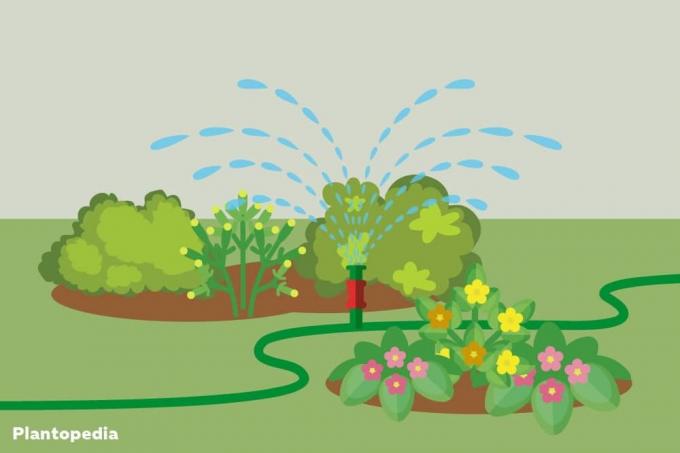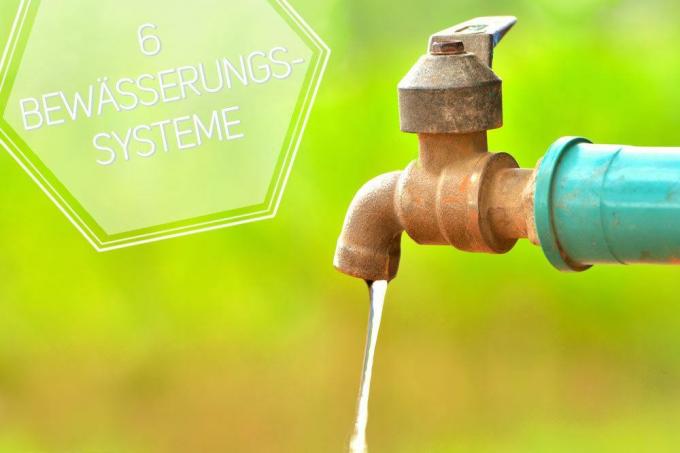
table of contents
- Irrigation systems for plants
- Watering can
- Casting balls
- Clay cone
- Irrigation through a "wick"
- Drip irrigation
- Irrigation system
The cultivation of plants always presents the hobby gardener with a wide variety of tasks and problems. With all plants, watering is a recurring theme. How do you irrigate correctly and which irrigation system is particularly suitable for the individual circumstances? We introduce the most common irrigation systems and explain advantages and disadvantages.
Irrigation systems for plants
There are different options for watering plants. Everyone likely has their own method of watering the plants. Have you already found the right one? We present different irrigation systems for plants.
Watering can
Of course, it does not represent a real "system", but since it can be used universally and is definitely known to every gardener, we do not want to leave out the watering can either.
Advantages:
- Individual watering quantity can be determined for each watering process and plant
- Regular control options through manual pouring, e.g. B. for diseases or parasite infestation
- Pesticides, fertilizers and other substances can easily be added
- Very inexpensive and can be used independently of space
Disadvantage:
- High personal effort due to manual filling, high weight and low filling volume
- Danger of irregularities due to manual determination of the water dose
- No automation possible

Casting balls
In terms of their functional principle, pouring balls resemble a rigid, upside-down bottle. Due to the resulting balance of gravity and vacuum, the water is held in the upper spherical area in the container by the rigid shell. From there it slowly seeps down through the opening and thus enables continuous watering of indoor plants as well as potted plants in the garden or on the balcony. Because a ball is only able to hold a single plant or at most a moderate size plant pot To supply several crops, such irrigation systems for beds in the greenhouse or in the field are entirely not suitable.
Advantages:
- Individual supply of individual plants or Plant pots
- Mostly visually very appealing, e.g. B. as a clay ball or glass element
- Individual addition of fertilizer possible
Disadvantage:
- Limit the amount of water
- Cannot be used in the garden, e.g. B. in the greenhouse or in the field
- Cannot be used in pots that are too small and without sufficient space next to the plant
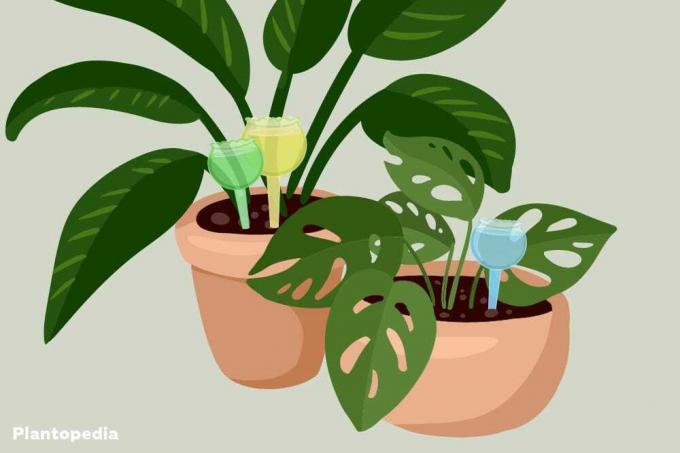
Note: There are casting balls in different shapes and designs. They can be made of clay, ceramics or glass as a decorative design element on the windowsill, on the balcony or in the planters in the garden.
Clay cone
The clay cone follows a similar approach to the casting ball. However, in this case the water is traditionally held in place by the closed container. Tucked into the ground next to the plant, the water migrates through the porous clay material and permanently escapes in small quantities on the surface. In this way, particularly even, if not too intensive, irrigation can be achieved.
Positive:
- No technical facilities required
- Even, permanent water release
- Mostly high aesthetic value of the tone elements
- also possible as an adapter for PET bottles
Negative:
- The pouring amount is severely limited
- Not suitable for large planters or outdoors
- Over time, unattractive discoloration of the porous clay from lime, algae and moss
- only very limited controllability of the amount of water released to the plants
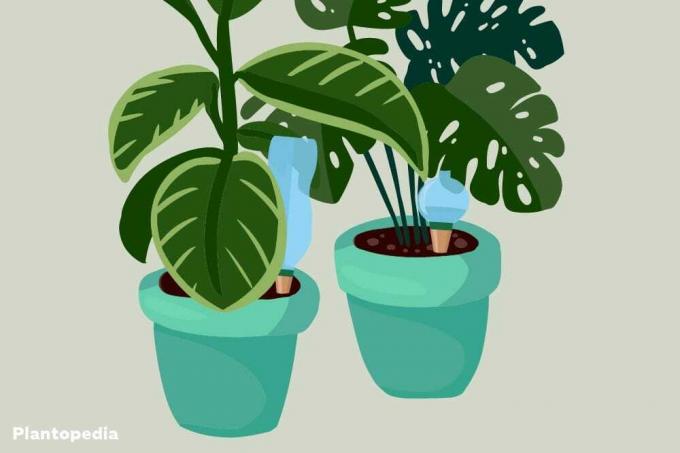
tip: If a clay cone shows the inevitable traces of lime and vegetation, the stained, greenish-white coating can be easily removed by bathing in vinegar water. However, you should make sure to soak the clay again intensively in clear water after the vinegar bath. Otherwise, transfer the vinegar solution stored in the clay into the soil first.
Irrigation through a "wick"
Cords or ribbons made of wool, cotton, or hemp tend to pull moisture into the fabric. This is known, for example, from wet shoelaces or the string on the tea bag. The effect can also be used very well to water indoor plants. Often a spacious coaster or another, usually ceramic, water reservoir is used Such a wick water through the drainage holes of the actual flower pots from below into the ground guided. Alternatively, for example with makeshift arrangements while on vacation, a fuse can simply be guided into each individual planter from a bucket standing next to the pots.
Advantages:
- Almost invisible from the coaster
- Very easy to create with little effort
- Individual watering of each individual plant is possible
- Regulation of the amount of water via the amount and thickness of the wicks
Disadvantage:
- Not for very large indoor plants or plant beds etc. applicable
- Additions of fertilizer are only possible to a limited extent due to the filter effect of the textile wicks
- Limited storage volume with reservoir in coaster
Drip irrigation
As a permanently installed irrigation system, drip irrigation offers a significant leap in comfort compared to the classic watering can. Permanently laid pipes release water drop by drop and thus irrigate permanently or at time intervals specified by the control. Either this system is installed permanently in the ground once, or it is laid on the ground for one season at a time.
Then, before the onset of frost, dismantling must take place in order to avoid frost damage in the comparatively thin water-carrying pipes. Due to the high effort and the necessary lines, drip irrigation is primarily suitable for the garden. Smaller systems for the balcony or even indoor plants, on the other hand, can only be found sporadically.
Positive:
- Automated system, so no casting effort
- Constant soil moisture through permanent or at least phased watering
- Clearly adjustable pouring quantities
- Easy to adapt to changes or extensions through new garden design
Negative:
- High installation effort, one-time or seasonally recurring
- very susceptible to frost
- Addition of fertilizers or pesticides is not possible or only possible with great effort
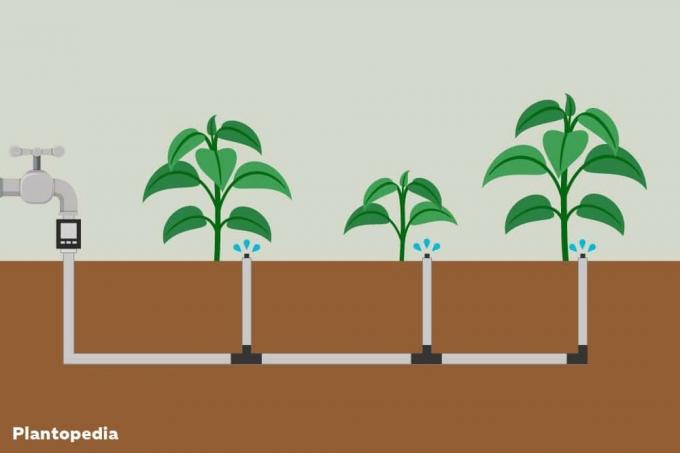
tip: A workable solution is offered by a firm built-in drip irrigationwhich, however, has the option of emptying it over the winter. In this way, the built-in technology can remain in the ground, whereas the critical medium - the water - can simply be drained off. In this way you can enjoy the advantages of the permanent installation, but avoid its disadvantages at the same time
Irrigation system
What happens in commercial horticulture in the form of complex technical irrigation systems can be done privately with a simple one Garden sprinkler be accomplished. Similar to natural rain, water is added drop by drop from above over a longer period of time. In this way, the water can seep into the ground permanently and also reach greater depths. As a mobile system, the garden sprinkler can be placed anywhere and can also be used for large areas. Fixed in the ground, on the other hand, it offers the great convenience of independent irrigation. Despite the technically different designs, these are not different irrigation systems, but only different forms of an operating principle.
Positive:
- Large irrigation areas achievable
- Even, intensive application
- Permanently installed, independent function possible via control
Negative:
- Not for balconies, planters etc. suitable
- Dependent on uniform cuts of the irrigation areas
tip: Optimal irrigation can be achieved with comparatively little effort if there are already fixed water extraction points in the garden. A mobile sprinkler can use them to reach all parts of the garden, while the annoying effort of laying the garden hose is reduced to a minimum. In addition, in contrast to a completely permanently installed sprinkler, the water extraction points offer the possibility of connecting other uses or pouring methods.
